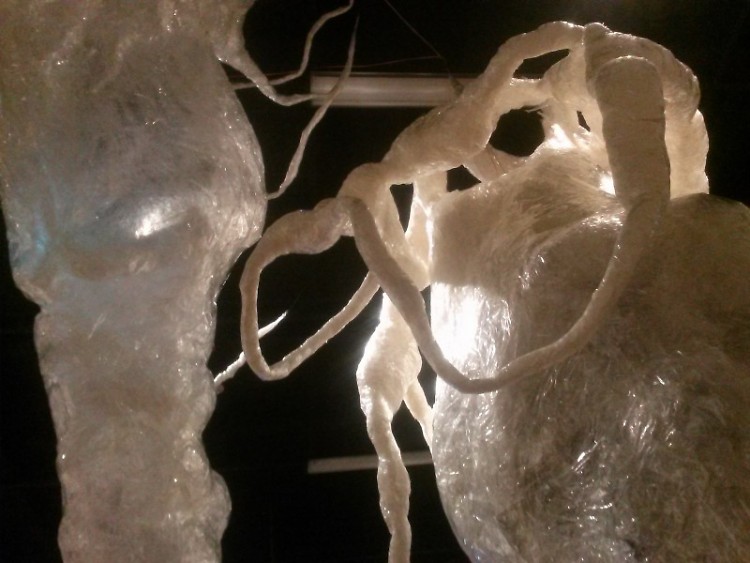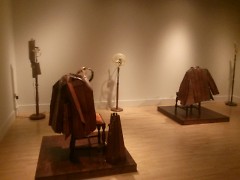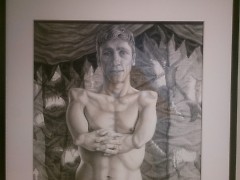The author's previous review of "Art of the Lived Experiment" at the UICA can be found here.
A friend of mine pointed out that there's a difference between an art exhibit's curation and its design: Curation is the selection of pieces for an exhibit, and an exhibit's design is how those pieces are arranged and displayed. As I mentioned previously, the UICA's portion of "Art of the Lived Experiment" suffers from poor design and inaccessible layout. However, both exhibits at KCAD's Fed Gallery, "Art of the Lived Experiment" and Icebreaker, are designed well, are more accessible, and include a wider variety of mediums.
Technology and Engagement
There's a sign at the very front of the Fed Gallery that tells guests that they can exchange a state-issued ID for an iPad loaded with the "Access UICA" app. Apparently, these iPads are also available at the UICA's Guest Services desk, but this service is not publicized particularly well.
The app is nice, and does provide additional information about the artists and background information about their work. I would like if it also included clips from performance-based works, like Brian Catling's "Notes and Bones from a Conjuror's Table." However, the app isn't needed to have an enriching experience, or to obtain basic backround information about the art on display: KCAD and the Fed Gallery do an excellent job of providing annotations throughout the exhibit. They use technology as it should be used: as a supplement to the artwork, but not as a replacement for providing visitors with basic information.
Sense Memory
KCAD did an excellent job featuring work that stimulated all senses. Ellie Collins' "Haptic Objects" were placed all across the exhibit, and visitors could touch and handle strips of neoprene, metal chains, merino wool and a ceramic toilet. Anna Berndtson's video "Duckie" is a study in contrasts: the sound of rubber ducks squeaking is juxtaposed with a figure stomping on those ducks menacingly towards the viewer. The exhibit layout had a nice flow to it, and there weren't areas or spaces prone to traffic jams or bottlenecks.
"Self-Preservation"
The standout work is Riva Lehrer's drawing of Mat Fraser as "Sealo Seal Boy" and the accompanying documentary "Self Preservation: The Art of Riva Lehrer." The documentary follows Lehrer and the subjects of her "Circle Stories" series of portraits. In "Circle Stories" Lehrer paints "portraits of people with careers in the arts, academia, and political activism. Each has a significant physical disability, and explores body issues in his or her own work." In the film, Lehrer's subjects praise her for her use of symbolism, and her creation of portraits that challenge stereotypical depictions of disability. One portrait subject, Chicago performer Tekki Lomnicki exclaims "she [Lehrer] even gave me cleavage!"
Lehrer's portrait of Fraser, best known for his role on "American Horror Story: Freak Show," combines her use of personal artifacts (a small straight razor used in his act as Sealo the Seal Boy), and classical styling and pose. Fraser is nude, and stares confidently at the viewer with his hands folded across his chest, and his hip slightly cocked. It's a fitting portrait for a man who once said "For me, when you're disabled, the two things people think you can't do are fight and have sex. So I've got a black belt and I'm really good at shagging."
"Icebreaker"
Across the hallway, the "Icebreaker" exhibit pairs nicely with "Art of the Lived Experiment," highlighting local artists and events while also appealing on multiple sensory levels. Natalie Wetzel's scupture and installation "Great Glob" combines sound from a New Fumes performance with sculpture. "Great Glob" is exciting, fun and a little overwhelming. "Etch," a film and dance piece by Dance In The Annex ,features Toni Bal, who is also profiled in Tom Wagner's short film "Moving In Art, a portrait." In the film, Bal explores Site:Lab's installation at the Morton during Artprize 2014. In "Shaking Hands, a portrait." Wagner profiles Grand Rapids photographer Robert Andy Coombs. Coombs discusses his process, his desire to shoot for Vogue, and life as a disabled gay man. "Shaking Hands" dovetails nicely with Riva Lehrer's work, and both exhibits work nicely together.
Design Makes a Difference
What sets apart KCAD's portion of "Art of the Lived Experiement" is the design and layout of artwork. Both exhibits at KCAD were designed with clarity and ease of navigation in mind, and should be the standard used in planning accessible art exhibits in the future.
The Rapidian, a program of the 501(c)3 nonprofit Community Media Center, relies on the community’s support to help cover the cost of training reporters and publishing content.
We need your help.
If each of our readers and content creators who values this community platform help support its creation and maintenance, The Rapidian can continue to educate and facilitate a conversation around issues for years to come.
Please support The Rapidian and make a contribution today.


